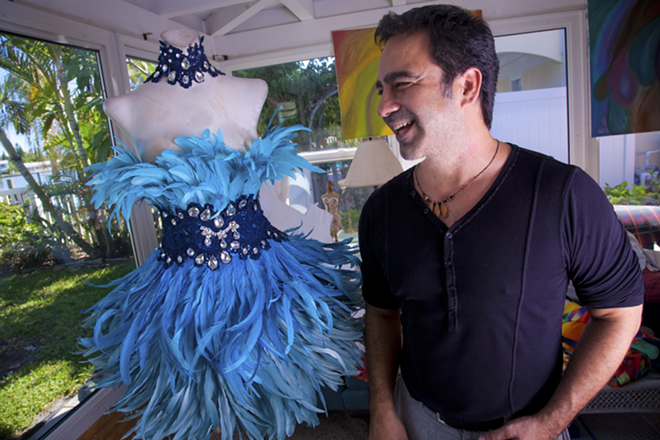
Rogerio Martins was living in his hometown, São Paulo, Brazil, and working for a TV station when a friend suggested moving to New York for six months. “Why not?” Martins thought. But when their Big Apple sublet fell through, he and his friend wound up taking an extended vacation in Clearwater.
Ten years later, Martins looks out the windows across from his dining room table onto a beautiful view of Boca Ciega Bay on Redington Beach. A patio studio encased in glass holds his works-in-progress: one-of-a-kind costumes crafted from feathers, sequins, lycra and foam, draped upon mannequins. Over breakfast on a Friday morning, he reflects on the unexpected course of his life.
“If I had stayed in Brazil, I don’t think I would be a fashion designer,” Martins says. “It was a twist.”
On Saturday, Martins headlines Wearable Art 8, the Dunedin Fine Art Center’s annual fashion show devoted to works that aren’t exactly run-of-the-mill garments. More like moving sculptures, paintings with armholes and other genre-defying mash-ups of costume, artwork and performance, the pieces on display in Wearable Art often elicit a gasp or giggles. In past years, highlights have included balloon dresses designed by magician Mark Byrne and sculptor Frank Strunk III’s elaborate aluminum and copper dresses, corsets and bras. Alternately lighthearted and racy, the show attracts a devoted crowd.
This year’s Wearable Art features a formidable lineup of talent. Byrne is back with his crowd-pleasing balloon creations, and returnees from last year’s show include husband-and-wife team Rocky and Kathleen Bridges (they design with found metal and other materials) and eco-couturier Johnny Hunt (who crafted skirts and coats from grass in 2011). They’ll be joined by the Garden Fairies, Michael Della Penna and Scott Durfee and George Medeiros, a collaborative duo who make surprisingly elegant handbags out of palm tree spathes.
But it’s Martins — in my estimation, at least — who makes Wearable Art the best art-inflected fashion show in Tampa Bay, particularly since the departure from the show of Frank Strunk two years ago.
Martins’ foray into design has been a case of accident leading to personal reinvention. During a second six-month visit to Florida from Brazil, he began a new hobby on a whim — making sculptures out of found materials like egg shells, lampshades, a table top and other everyday detritus. Somehow, one of the sculptures — perhaps a piece of painted canvas — led Martins to create an outfit. By 2005, he was a student in fashion design at the International Academy of Design and Technology in Tampa (going for his second degree), and by 2007 he was contributing elaborate, sculpture-like garments to Wearable Art.
“Something spoke to me here,” Martins says.
Those early creations established a standard at Wearable Art. Now many of the show’s designers employ “recycled” materials, but Martins’ dresses made from dried chili peppers, rice and beans, lentils (fashioned into a beautiful green tunic), palm fronds, sea grape leaves, and plastic wrap were the first to make jaws drop in Dunedin with their meticulous craft and witty choice of materials. A few years back, he dressed frequent collaborator Alice Ferrulo, a dancer and performance artist, in a bikini made of raw meat and sent her down the runway.
“That was before Gaga,” Martins emphasizes.
Last year, he dressed Ferrulo as a queen in a fabric gown with an elaborate gold wire skirt constructed by another collaborator, artist Rebecca Skelton. This year, he’s making a costume for her inspired by the lotus flower, a plant that signals purity, unity and beauty in Asian cultures. Tiers of hand-crafted foam petals and a hat made from an inverted lampshade make up the dramatic white ensemble. In striking contrast, his other five outfits for Saturday’s show are colorful creations modeled after Amazonian birds — yellow, black and blue-green concoctions of sequins and feathers. While the lotus dress will keep Ferrulo’s body under wraps, the bird-inspired garb is designed to reveal considerably more flesh.
Meanwhile, Martins is working on his spring 2013 collection of women’s ready-to-wear day dresses, which he’ll show at Tampa Bay Fashion Week in September. Last fall, he released a spring 2012 collection of 11 dresses — his first — under the label Sayzar (a phonetic spelling of his middle name) that was picked up by boutiques in Sarasota, Naples, Boca Raton and other Florida cities. A far cry in terms of flamboyance from his Wearable Art pieces, the 2012 dresses updated classic silhouettes (e.g., a sheath dress with a cowl neck) in white Italian cottons printed digitally with abstract designs. The 2013 dresses — 18 in total — are lighter and airier in sheer floral prints, including one in bright chartreuse. They retail for $200 or less.
Along with one-of-a-kind couture pieces for individual clients, like a black minidress made of more than 500 knotted lycra ribbons, Martins’ budding collections are his bread and butter. But Wearable Art maintains a special claim on his heart, time and attention because the event lets his creativity run wild in pursuit of making women look beautiful in beautiful outfits.
And at the end of that day, that’s what designing is all about for Martins.
“If you don’t love who you design for, forget about it,” he says.

